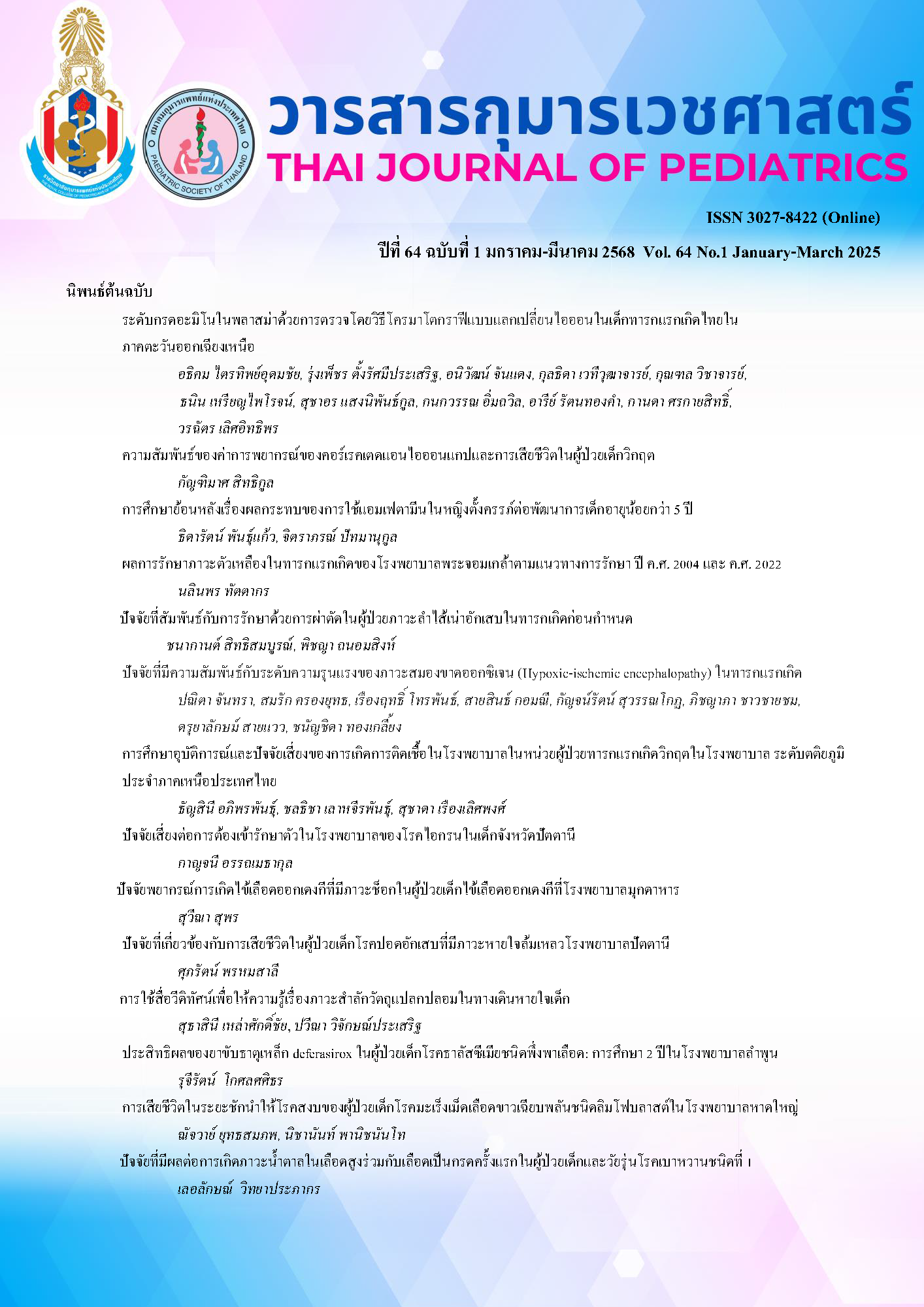Factors affecting the severity of hypoxic-ischemic encephalopathy in the neonatal intensive care unit
Keywords:
Hypoxic-ischemic encephalopathy, Group B streptococcus infection, infant age 9 months, Neonatal intensive care unit, Risk factorsAbstract
Background: Hypoxic-ischemic encephalopathy (HIE) leads to brain injury and disability in newborns. Other risk factors include fetal oxygen deprivation and intrapartum factors. Examining factors affecting the severity of HIE will help improve the effectiveness of prevention, diagnosis, and treatment methods.
Objective: This study aimed to investigate the factors that influence the HIE in neonates admitted to the neonatal intensive care unit (NICU).
Methods: A retrospective study was conducted by collecting data from medical records of newborns diagnosed with HIE and admitted to the NICU. Data were analyzed using descriptive statistics and Fisher’s exact tests. The relationships among different elements and HIE intensity were also identified.
Results: There was no statistically significant difference between the infants’ gender, mode of delivery, maternal underlying diseases, birth weight, APGAR score at 5 minutes, pulse rate at 5 minutes, and the type of ventilation. Statistically significant differences were found in infection (p value 0.003). Infants with infection and shock were more likely to develop severe HIE.
Conclusion: Infection was a major factor influencing the severity of HIE in newborns.
Downloads
References
Shankaran S. Hypoxic-ischemic encephalopathy and novel strategies for neuroprotection. Clin Perinatol. 2012;39:919-29.
Acun C, Karnati S, Padiyar S, Puthuraya S, Aly H, Mohamed M. Trends of neonatal hypoxic-ischemic encephalopathy prevalence and associated risk factors in the United States, 2010 to 2018. Obstet Gynecol Surv. 2023;78: 257-9.
Douglas-Escobar M, Weiss MD. Hypoxic-ischemic encephalopathy: A review for the clinician. JAMA Pediatr. 2015;169:397-403.
Namusoke H, Musoke NM, Ssebunya R, Kirabira NV, Mworozi E. Incidence and short term outcomes of neonates with hypoxic ischemic encephalopathy in a Peri Urban teaching hospital, Uganda: A prospective cohort study. Maternal Health, Neonatol Perinatol. 2018;4:6.
World Health Organization. Newborns: Improving survival and well-being [Internet]. Geneva: WHO;2023 [cited 2024 Sep 22]. Available from: https://www.who.int/news-room/fact-sheets/detail/newborns-reducing-mortality.
Wang Y, Luo S, Wang K, Hou Y, Yan H, Zhang Y. Maternal and neonatal exposure to risk factors for neonates with moderate or severe hypoxic ischemic encephalopathy: A cross-sectional study. Ital J Pediatr. 2022;48(1):188.
กระทรวงสาธารณสุข. แนวทางการดูแลรักษาภาวะสมองขาดออกซิเจนในทารกแรกเกิด. กรุงเทพฯ: โรงพิมพ์ชุมนุมสหกรณ์การเกษตรแห่งประเทศไทย; 2563.
วัลภา อุดชาชน. ผลการรักษาทารกที่มีภาวะสมองขาดออกซิเจนระยะปริกำเนิดโดยวิธีลดอุณหภูมิที่เข้ารับการรักษาในโรงพยาบาลขอนแก่น. วารสารกุมารเวชศาสตร์. 2566;62(4):340-9.
สมาคมเวชศาสตร์ปริกำเนิดแห่งประเทศไทย. แนวทางการดูแลทารกแรกเกิดในห้องผู้ป่วยหนัก. กรุงเทพฯ: บียอนด์ เอ็นเทอร์ไพรซ์; 2562.
McIntyre S, Nelson KB, Mulkey SB, Lechpammer M, Molloy E, Badawi N. Neonatal encephalopathy: Focus on epidemiology and underexplored aspects of etiology. Semin Fetal Neonatal Med. 2021;26:101265.
Vega-Del-Val C, Arnaez J, Caserío S, Gutiérrez EP, Benito M, Castañón L, García-Alix A. Temporal trends in the severity and mortality of neonatal hypoxic-ischemic encephalopathy in the era of hypothermia. Neonatology, 2021;118:685-92.
Cho KH. Evaluation and management of main bacterial infections in premature infants. J Korean Soc Matern Child Health. 2022;1:1-9.
Lv H, Liu F, Wang Q, Dong Z, Zhang H, Ren P, et al. Correlation analysis between the amniotic fluid contamination and clinical grading of neonatal hypoxic–ischemic encephalopathy and biomarkers of brain damage. BMC Pediatr. 2024;24:178.
Chong WH, Ong HY, Ooi JS, YY EK, Lim LM, Tew MM, et al. The effect of hypoxic ischemic encephalopathy towards multi-organ complications and its early outcome at a Malaysian district hospital. Med J Malaysia. 2024;79:184-90.
Dileep A, AlAbdin ZS, Aburuz S. Investigating the association between severity of COVID-19 infection during pregnancy and neonatal outcomes. Sci Rep. 2022;12:3024.
Atreya MR, Bennett TD, Geva A, Faustino EVS, Rogerson CM, Lutfi R, et al. Biomarker assessment of a high-risk, data-driven pediatric sepsis phenotype characterized by persistent hypoxemia, encephalopathy, and shock. Pediatr.Crit.Care.Med..2024;25:512-7.
Sanchez-Pinto LN, Stroup EK, Luo Y, Atreya MR, Wardenburg JB, Chong G, et al. Derivation, validation and clinical relevance of a pediatric sepsis phenotype with persistent hypoxemia, encephalopathy and shock. Pediatr Crit Care Med. 2023;24:795–806.
Wang Y, Zhang Y, Luo S, Wang K. Gender-specific association of multiple risk factors with neonatal moderate or severe hypoxic ischemic encephalopathy: A cross-sectional study. Ital J Pediatr. 2024;50:169.
Chen X, Chen H, Jiang D. Maternal and fetal risk factors for neonatal hypoxic-ischemic encephalopathy: A retrospective study. Int J Gen Med. 2023;31:537-45.
Downloads
Published
How to Cite
Issue
Section
License
Copyright (c) 2025 The Royal College of Pediatricians Of Thailand

This work is licensed under a Creative Commons Attribution-NonCommercial-NoDerivatives 4.0 International License.


